
Roots
The quiet rustle of leaves in an ancient grove, the gentle murmur of a stream over smooth stones – these are the sounds of origins, of foundations laid long before our conscious thought. So too, with the care of textured hair. To truly understand its modern manifestations, one must first feel the ground beneath our feet, reaching back into the deep soil of human history and cultural practice. Our journey into how cultural practices shape contemporary hair care for textured strands begins not with products or techniques, but with a reverence for what has always been ❉ the inherent beauty of hair in its natural state, and the wisdom passed down through generations.
Across continents and centuries, hair has served as far more than mere adornment. It has been a declaration of identity, a symbol of status, a canvas for artistry, and a repository of communal knowledge. For individuals with textured hair, particularly those of African descent, this connection runs exceptionally deep, often holding layers of meaning shaped by both celebration and resistance. Unearthing these historical roots provides not only context but a profound appreciation for the resilience and ingenuity embedded in every curl, coil, and wave.

What Constitutes Textured Hair Anatomically?
To speak of textured hair is to acknowledge a spectrum of structural variations, each possessing unique characteristics. At its most fundamental level, hair is a protein filament, primarily composed of keratin, emerging from a follicle within the skin. The shape of this follicle, along with the angle at which the hair shaft exits the scalp, plays a substantial role in determining curl pattern.
A flatter, more elliptical follicle often gives rise to curlier, coily strands, while a rounder follicle tends to produce straighter hair. This anatomical distinction is not a mere biological quirk; it directly influences how moisture travels along the hair shaft, how easily strands can tangle, and their propensity for dryness.
Furthermore, the distribution of disulfide bonds within the keratin structure itself contributes to the hair’s curvature. In highly coiled hair, these bonds are unevenly distributed, creating a more pronounced helical shape. This inherent structure, while beautiful, also presents specific care considerations.
The natural bends and turns along a coiled strand make it more challenging for the scalp’s natural oils, known as sebum, to travel from root to tip, often leading to increased dryness at the ends. Understanding these basic biological realities is a starting point for appreciating why culturally informed care practices developed as they did.

How Do Classification Systems Aid Understanding of Textured Hair?
The world of textured hair often employs classification systems, such as the widely recognized Andre Walker Hair Typing System, to categorize curl patterns. While these systems, typically ranging from Type 1 (straight) to Type 4 (coily), with sub-classifications like A, B, and C, offer a common language for discussion, their true utility lies in guiding care rather than strict categorization.
Understanding textured hair classification systems provides a common language for discussion, but their true utility resides in guiding personalized care rather than rigid categorization.
For instance, Type 4C hair, characterized by its tight, zig-zag coils, often experiences the most shrinkage and can be particularly prone to dryness and tangling due to its numerous bends. Type 3 curls, on the other hand, might have a more defined S-pattern and retain moisture more readily. These classifications help individuals identify general tendencies and product responses.
However, it is essential to remember that hair often displays multiple textures across a single head, and individual strands can defy neat labels. The real wisdom lies in observing one’s own hair, rather than rigidly adhering to a chart.
- Type 1 ❉ Straight hair, no natural curl.
- Type 2 ❉ Wavy hair, with a gentle S-shape.
- Type 3 ❉ Curly hair, forming distinct S-shaped curls.
- Type 4 ❉ Coily hair, with tight, often zig-zag patterns.
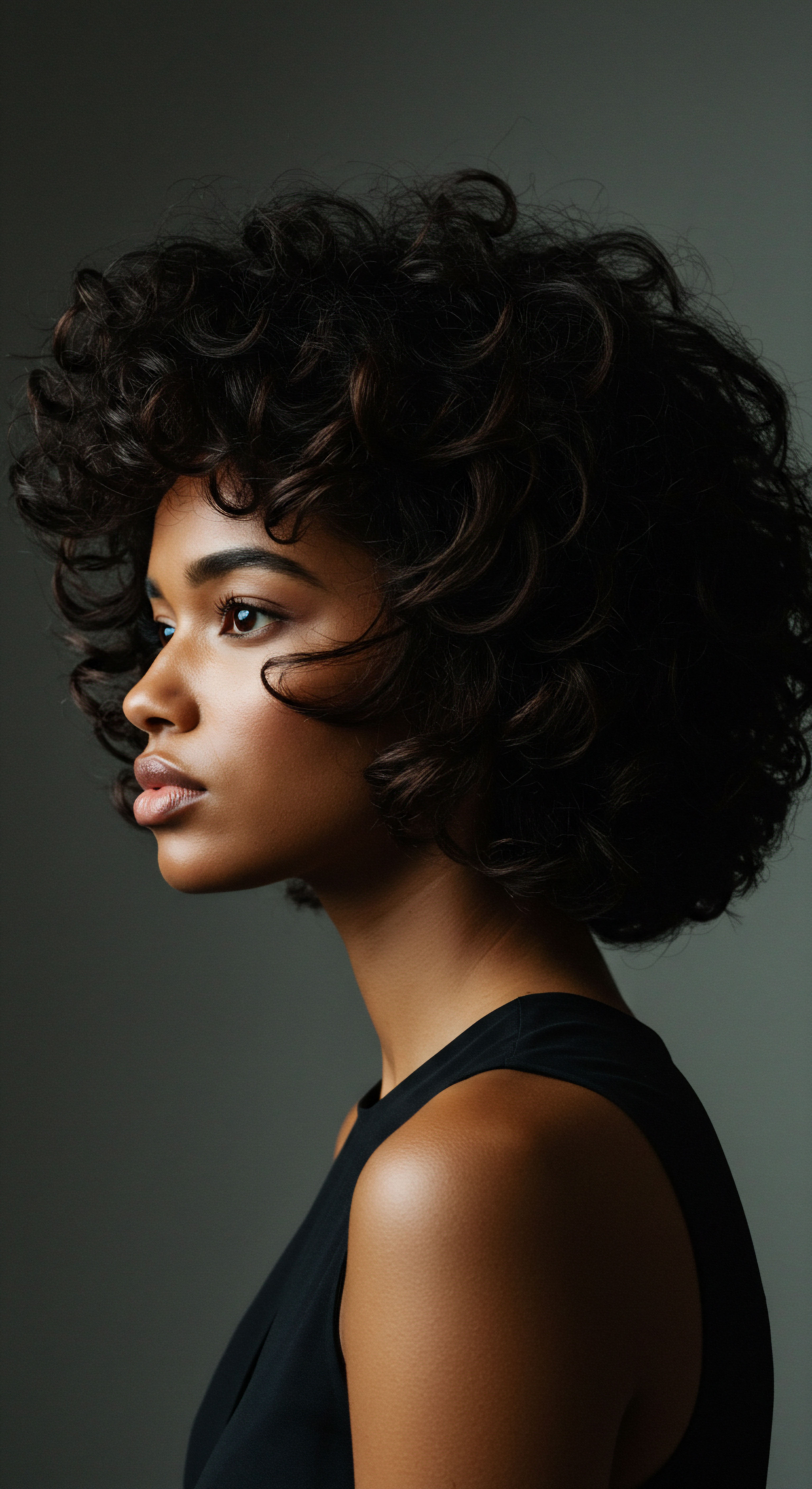
What is the Essential Lexicon of Textured Hair?
The language surrounding textured hair care is rich with terms that have evolved from both scientific understanding and lived experience. A glossary of these terms becomes a guide, illuminating the path to informed choices.
Consider terms like Porosity, which describes the hair’s ability to absorb and retain moisture. High porosity hair, with its raised cuticles, readily takes in water but also loses it quickly, necessitating products that seal in hydration. Low porosity hair, with tightly closed cuticles, resists moisture absorption but retains it well once hydrated.
Then there is Density, referring to the number of individual hair strands on the scalp, which influences product weight and styling choices. Understanding these terms empowers individuals to select products and practices that truly align with their hair’s specific needs, moving beyond generic advice.
Another key term is Shrinkage, the phenomenon where textured hair appears much shorter when dry than its actual length due to its coil pattern. While a natural characteristic, managing shrinkage often guides styling decisions and product choices. Terms like Co-Washing (conditioning washing), Pre-Poo (pre-shampoo treatment), and LOC Method (liquid, oil, cream layering) are not mere jargon; they represent established care routines that have proven beneficial for maintaining moisture and promoting the well-being of textured hair. This specialized vocabulary, deeply rooted in the community’s collective pursuit of optimal hair health, underscores the depth of knowledge cultivated around these hair types.

How Do Hair Growth Cycles and Influencing Factors Shape Care?
Hair growth occurs in cycles ❉ anagen (growth), catagen (transition), and telogen (resting/shedding). While these cycles are universal, various factors can influence their duration and the overall health of textured hair. Genetics play a substantial role, determining not only curl pattern but also growth rate and density. Nutritional intake directly impacts hair health, as deficiencies in vitamins and minerals can compromise strength and vitality.
Beyond biology, environmental factors like humidity, pollution, and even water hardness can influence textured hair’s condition. High humidity might cause frizz, while hard water can lead to mineral buildup, dulling strands and hindering moisture absorption. Moreover, mechanical stress from tight styling, excessive manipulation, or harsh brushing can lead to breakage, shortening the apparent growth cycle. A holistic view acknowledges these interwoven influences, guiding a more thoughtful approach to care that respects the hair’s natural rhythms and external pressures.
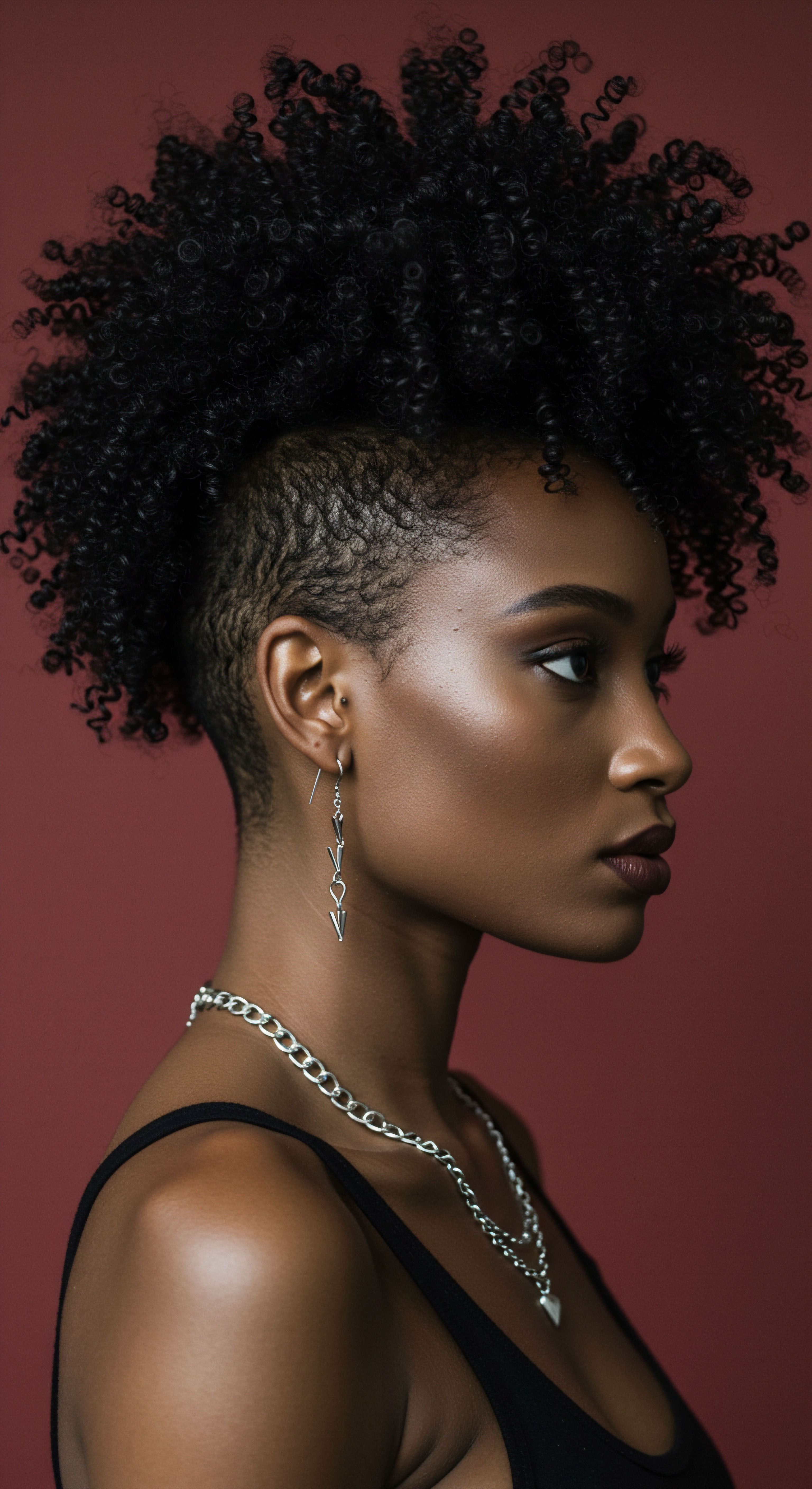
Ritual
Stepping from the quiet contemplation of roots, we move into the vibrant space of daily practices, the rhythm of hands caring for hair, the very essence of ritual. This section acknowledges the tangible yearning for practical wisdom, for methods that honor the inherent structure of textured strands while coaxing forth their natural beauty. Here, we delve into the applied knowledge, the techniques and tools that transform understanding into action, guided by a gentle hand and a purpose-driven spirit. The wisdom of generations, often shared in intimate settings, now finds its echo in modern approaches, blending tradition with contemporary insights.
The practices surrounding textured hair care are rarely arbitrary; they are often born from centuries of adaptation, necessity, and a deep appreciation for the hair’s unique needs. From ancient African protective styles designed to shield hair from the elements, to the precise art of product application developed in modern natural hair communities, each ritual serves a purpose, fostering health, strength, and a profound connection to self and heritage.

What are the Pillars of Protective Styling?
Protective styling stands as a cornerstone of textured hair care, a practice deeply embedded in cultural history. These styles, which tuck away the ends of the hair, minimize manipulation, reduce exposure to environmental stressors, and promote length retention. Braids, twists, and cornrows, in their myriad forms, have been worn for millennia across African cultures, often signifying age, marital status, or tribal affiliation. Today, they continue to serve as a practical and aesthetic solution for textured hair.
The true artistry of protective styles lies not only in their visual appeal but in their function. They shield the most vulnerable parts of the hair – the ends – from friction and breakage, allowing the hair to rest and grow. While the aesthetic variations have expanded, the underlying principle remains unchanged ❉ to preserve and protect.
A well-executed protective style begins with properly cleansed and moisturized hair, ensuring the strands are hydrated before being set. The tension applied during the styling process must be gentle, avoiding excessive pulling that could lead to traction alopecia, a concern that modern hair wellness advocates emphasize. The longevity of these styles, often weeks at a time, necessitates careful scalp care and periodic refreshing to maintain scalp health and prevent product buildup.
| Style Box Braids |
| Description Individual plaits created with or without extensions. |
| Primary Benefit Versatile, long-lasting, significant length retention. |
| Style Twists |
| Description Two strands of hair wrapped around each other. |
| Primary Benefit Less tension than braids, good for moisture application. |
| Style Cornrows |
| Description Braids styled flat against the scalp in rows. |
| Primary Benefit Scalp access, foundation for wigs/weaves. |
| Style Bantu Knots |
| Description Small, coiled buns formed by twisting hair. |
| Primary Benefit Heatless curl definition, scalp access. |
| Style These styles offer both aesthetic appeal and practical hair health advantages. |

How Can Natural Styling Techniques Define Textured Hair?
Beyond protective measures, a realm of techniques exists to enhance and define the natural curl pattern. These methods celebrate the hair’s inherent texture, allowing it to unfurl in its authentic glory. The Wash and Go, for example, is a foundational approach where hair is cleansed, conditioned, and then styled while wet to encourage curl clumping and definition, often with the aid of leave-in conditioners, gels, or custards. The success of a wash and go relies heavily on product layering and application technique, ensuring even distribution and minimal disturbance of the curl pattern as it dries.
Another popular method is the Twist-Out or Braid-Out, where hair is sectioned, twisted or braided while damp, and then unraveled once dry to reveal elongated, defined waves or curls. This technique offers more stretch and definition than a wash and go, reducing visible shrinkage. The choice of styling product – a creamy styler for softness, a gel for hold – significantly influences the final result. These practices are not just about aesthetics; they represent a conscious choice to work with the hair’s natural inclinations, rather than against them, a principle that resonates deeply with the Roothea philosophy.
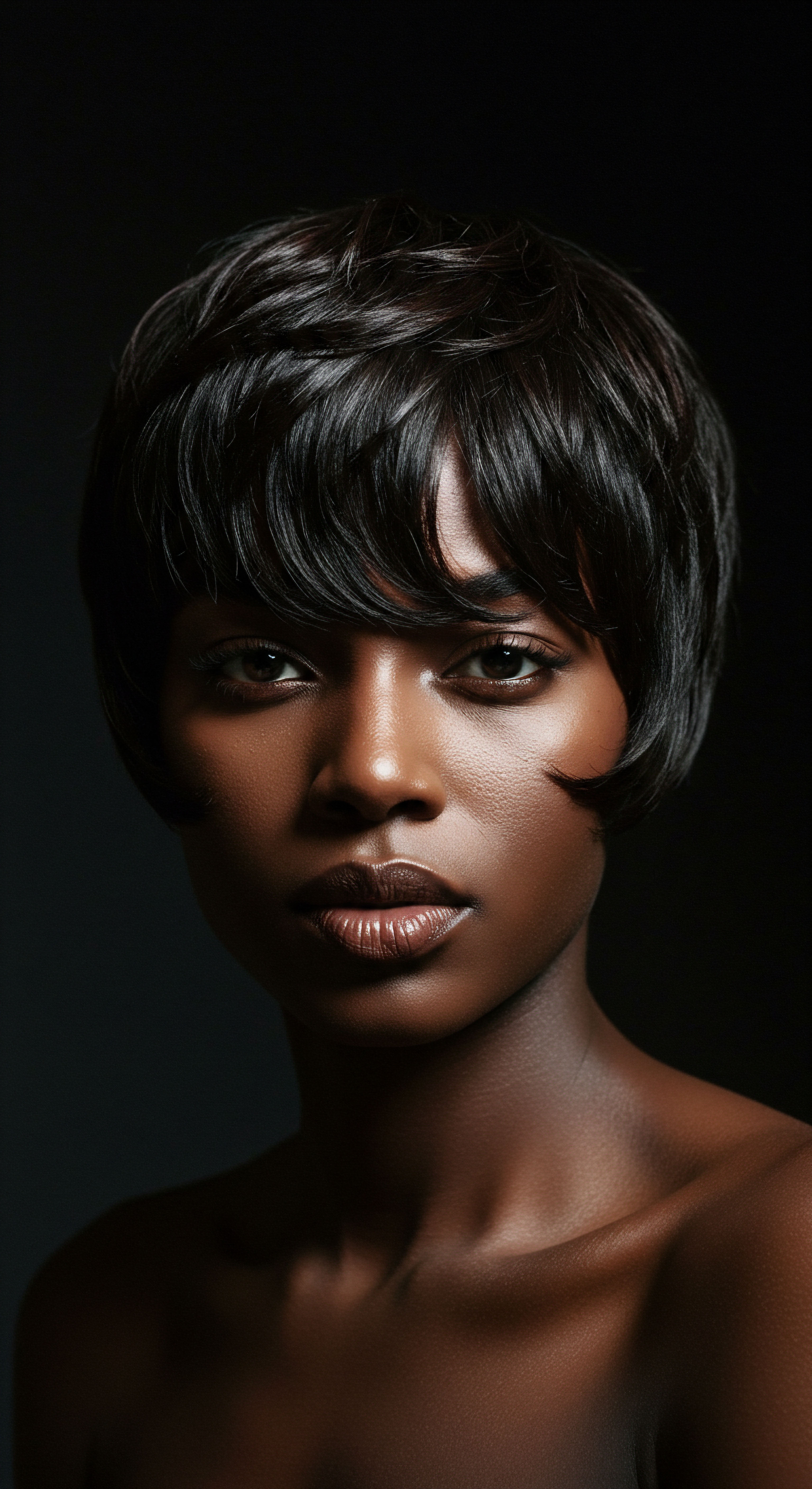
What Mastery is Required for Wigs and Hair Extensions?
Wigs and hair extensions, while sometimes viewed through a lens of purely aesthetic transformation, possess a rich cultural history of their own, particularly within Black communities. Historically, they served various purposes, from protective measures to expressions of social standing and creative artistry. In modern hair care, they continue to offer versatility, allowing for dramatic changes in appearance without altering one’s natural hair, while also serving as excellent protective styles.
Mastering the use of wigs and extensions involves understanding proper installation techniques that minimize tension on the scalp and edges, preventing damage to the natural hair underneath. This includes choosing appropriate cap constructions for wigs or attachment methods for extensions that allow the scalp to breathe and remain accessible for cleansing. Regular maintenance, including gentle cleansing of the natural hair and scalp, is essential to prevent buildup and maintain hygiene. The careful selection of hair type, whether synthetic or human, and its compatibility with desired styles and maintenance routines, also speaks to a nuanced understanding of these versatile hair enhancements.

How Can Heat Styling Be Approached with Safety First?
Heat styling, while offering temporary textural changes, demands a meticulous, safety-first approach for textured hair. Tools like flat irons and curling wands can create sleek or wavy looks, but the intense heat can compromise the hair’s delicate protein structure, leading to dryness, breakage, and irreversible heat damage.
Heat styling for textured hair necessitates a safety-first approach, prioritizing thermal protection and mindful application to preserve the hair’s delicate protein structure.
The cultural context here is significant; for decades, chemical relaxers and high heat were often used to achieve straight hair, a practice sometimes influenced by societal pressures to conform to Eurocentric beauty standards. Modern textured hair care advocates for minimizing heat exposure, and when heat is applied, it should be with the utmost care. This involves using a high-quality heat protectant, employing the lowest effective temperature setting on styling tools, and limiting the frequency of heat application. The goal is to achieve the desired temporary style without sacrificing the long-term health and integrity of the natural curl pattern.
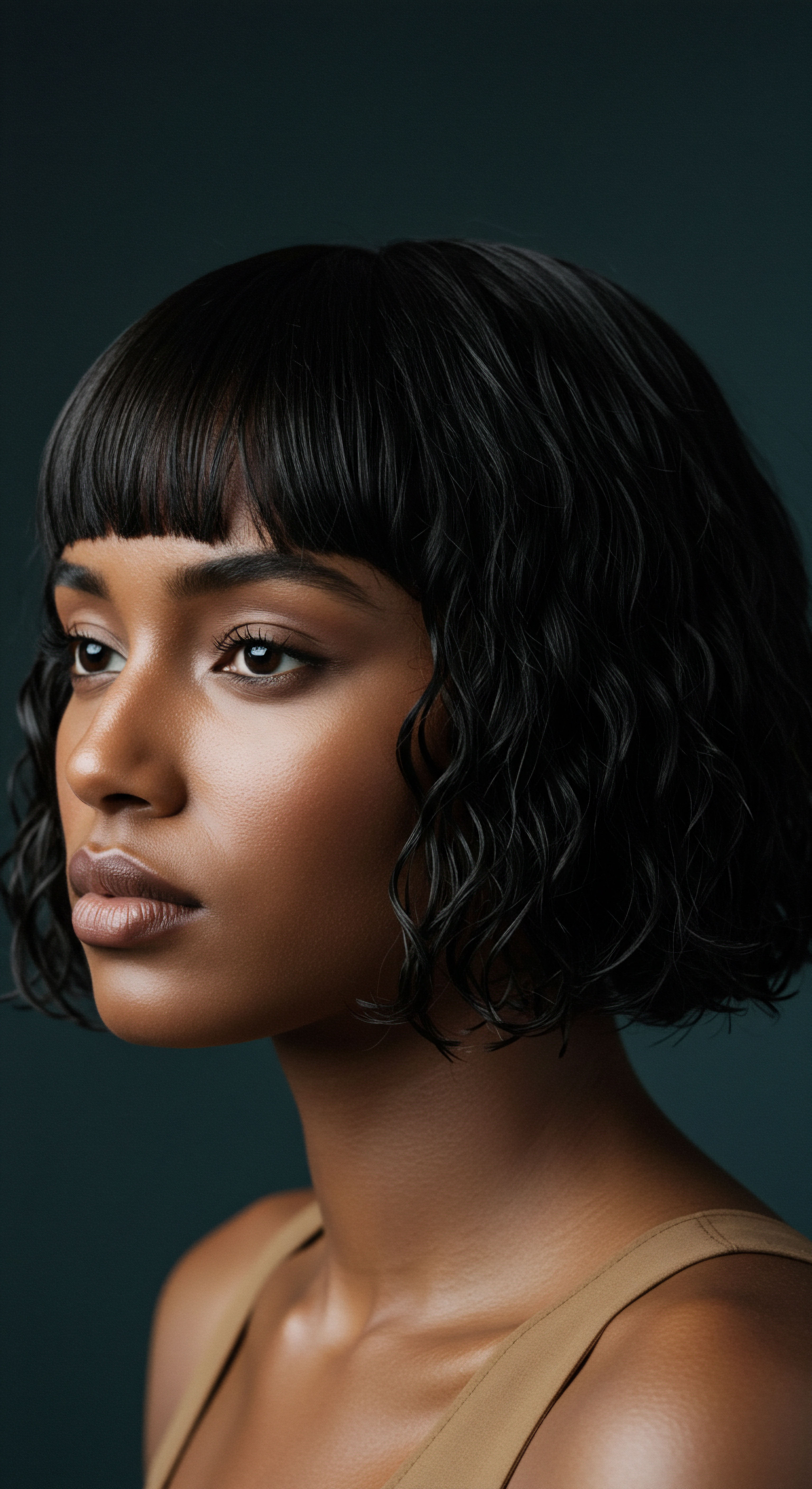
What Constitutes the Complete Textured Hair Toolkit?
Just as an artist selects their brushes with intention, so too does a mindful individual curate their textured hair toolkit. The right tools enhance the effectiveness of care rituals and prevent unnecessary stress on the hair.
- Wide-Tooth Comb ❉ Essential for detangling wet, conditioned hair, minimizing breakage.
- Spray Bottle ❉ Perfect for dampening hair before applying products or refreshing curls.
- Microfiber Towel or Old T-Shirt ❉ Gentler than terrycloth towels for drying, reducing frizz.
- Satin or Silk Scarf/bonnet ❉ Protects hair at night, reducing friction and moisture loss.
- Hair Clips or Sectioning Clips ❉ Aid in organizing hair for easier product application and styling.
Beyond these staples, specific brushes, like a denman brush for curl definition or a soft bristle brush for styling edges, may find a place in one’s collection. The emphasis lies on tools that respect the hair’s fragility and help distribute products evenly, rather than causing mechanical stress. The careful selection of these implements is a testament to the personalized and thoughtful nature of modern textured hair care.

Relay
From the foundational understandings of hair anatomy and the daily dance of care rituals, we now extend our gaze to the interconnected web of influences that shape modern textured hair practices. This segment invites a deeper reflection, a consideration of how historical narratives, scientific advancements, and contemporary societal shifts intertwine, creating a complex yet beautiful landscape for textured hair. We explore the profound insights that emerge when science and cultural wisdom meet, allowing for a truly holistic and informed approach to hair wellness.
The journey of textured hair care is not a linear progression; rather, it is a dynamic conversation between the past and the present, tradition and innovation. This ongoing dialogue reveals not only how far we have come but also the persistent challenges that continue to shape the experiences of individuals with textured hair worldwide.

How are Personalized Textured Hair Regimens Built?
The notion of a one-size-fits-all hair care routine dissolves when considering the unique needs of textured hair. Building a personalized regimen is an art, informed by scientific understanding and an individual’s specific hair characteristics, lifestyle, and cultural context. It begins with observation ❉ understanding one’s hair porosity, density, and elasticity. From there, a sequence of cleansing, conditioning, and styling steps can be tailored.
For example, individuals with very dry, high porosity hair might opt for a sulfate-free cleansing conditioner (co-wash) more frequently than a traditional shampoo, followed by rich leave-in conditioners and heavy sealants. Those with finer, lower density hair might choose lighter products to avoid weighing down their strands. The regularity of deep conditioning treatments, protein treatments, and clarifying washes is also adjusted based on the hair’s response and environmental factors. This customization, often learned through experimentation and shared community knowledge, stands as a hallmark of effective modern textured hair care.

What is the Nighttime Sanctuary of Sleep Protection and Bonnet Wisdom?
The ritual of nighttime hair protection holds deep cultural significance, particularly within Black communities, where bonnets, scarves, and durags have long served as essential tools. This practice extends beyond mere preservation; it is a quiet act of care, safeguarding the day’s styling and, more importantly, the hair’s precious moisture. The use of satin or silk fabrics for these coverings is not arbitrary; these materials create a smooth surface, reducing friction between the hair and coarser bedding materials like cotton. This reduction in friction minimizes tangling, breakage, and the absorption of moisture from the hair, which cotton readily does.
This tradition of covering hair at night speaks to a collective wisdom about maintaining hair health over time, preventing unnecessary damage, and extending the life of styles. It is a simple yet profound act of self-preservation, ensuring that the hair remains hydrated and protected, ready for the day ahead. This practical application of knowledge, passed down through families, exemplifies how cultural practices directly inform daily hair care decisions for textured hair.

Which Ingredients Hold Significance for Textured Hair Needs?
The modern textured hair market has seen an explosion of products, each promising unique benefits. Yet, discerning which ingredients truly serve the needs of textured hair requires a critical eye, often informed by both scientific understanding and traditional knowledge. Ingredients like shea butter, coconut oil, and castor oil, long used in African and diasporic hair care traditions, are now celebrated in mainstream formulations for their moisturizing and sealing properties. These natural emollients help to soften strands and reduce moisture loss, addressing the inherent dryness often associated with coily textures.
Conversely, there is a growing awareness of ingredients to avoid, particularly those found in older formulations aimed at altering textured hair. For instance, some hair relaxers and straighteners historically contained chemicals like formaldehyde, which has been linked to various health concerns. A study published in 2019, which tested 18 hair products commonly used by Black women, detected 45 harmful chemicals, including some regulated by California’s Proposition 65 or prohibited under the EU’s cosmetics law, with many of these not even disclosed on the product label.
This stark reality underscores a significant point ❉ the natural hair movement and the cultural shift towards embracing authentic textures have not only transformed beauty standards but have also propelled a demand for cleaner, safer product formulations. This movement is, in many ways, a response to historical practices that prioritized conformity over health, driven by external pressures and a lack of scientific understanding regarding the long-term impact of certain chemicals.
The shift towards “clean beauty” within the textured hair community is a powerful example of how cultural practices, born from a desire for self-acceptance and well-being, directly influence product innovation and consumer demand. It speaks to a collective re-evaluation of what constitutes healthy hair, moving away from a pursuit of altered textures towards a celebration of natural states, supported by ingredients that genuinely nourish and protect.
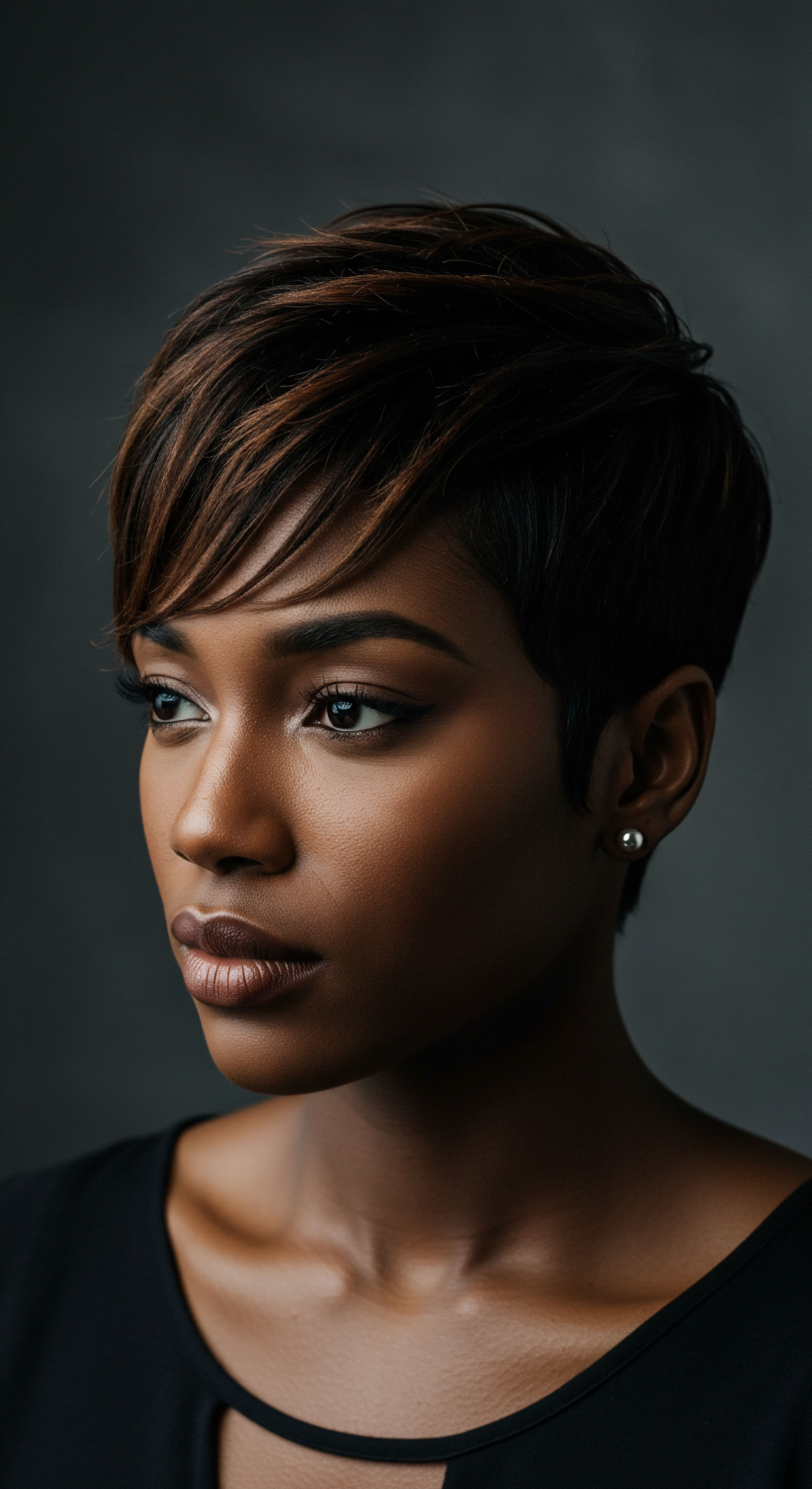
How Do Holistic Influences Shape Hair Health?
The health of textured hair is not an isolated phenomenon; it is deeply interconnected with overall well-being. A holistic perspective recognizes that diet, stress levels, hydration, and even emotional states can profoundly impact hair vitality.
A diet rich in proteins, vitamins (especially biotin, vitamin D, and iron), and healthy fats provides the building blocks for strong hair. Chronic stress can disrupt the hair growth cycle, leading to increased shedding. Adequate water intake is essential for cellular function throughout the body, including the scalp and hair follicles. Moreover, the psychological burden of hair discrimination, as highlighted by studies, can have a tangible impact on self-perception and mental wellness, which in turn can indirectly affect hair health.
Hair health, especially for textured strands, reflects overall well-being, deeply influenced by diet, stress, hydration, and the psychological impact of societal perceptions.
The CROWN Act, legislation aimed at prohibiting discrimination based on hair texture and protective hairstyles, stands as a testament to the societal pressures historically faced by individuals with textured hair. Studies show that Black women’s hair is 2.5 times more likely to be perceived as unprofessional, and approximately two-thirds (66%) of Black women change their hair for a job interview, with 41% changing from curly to straight. This pervasive discrimination can contribute to stress and affect self-esteem, illustrating how external cultural biases can influence personal hair care choices and, by extension, holistic health. A truly supportive hair care approach acknowledges these broader influences, promoting not just healthy strands but also a healthy sense of self.
The interplay of these factors means that caring for textured hair extends beyond product application; it becomes a practice of self-care, mindfulness, and a celebration of identity in the face of persistent societal narratives.

What Are Common Textured Hair Problems and Their Solutions?
Textured hair, with its unique structure, often presents specific challenges that have led to the development of targeted solutions within cultural care practices.
- Dryness ❉ Due to the coiled structure, sebum struggles to travel down the hair shaft.
- Solution ❉ Regular deep conditioning, use of humectants and emollients, the LOC or LCO method (liquid, cream, oil) for moisture layering, and protective styling.
- Breakage ❉ Fragile points along the coil, friction, and improper detangling can lead to snapping.
- Solution ❉ Gentle detangling with wide-tooth combs on wet, conditioned hair, minimizing manipulation, protective styles, and silk/satin pillowcases or bonnets.
- Tangles and Knots ❉ Coils naturally interlock, leading to knots, especially single-strand knots.
- Solution ❉ Finger detangling, sectioning hair during washing and conditioning, regular trims, and consistent moisture.
These solutions are often rooted in practices passed down through generations, refined with modern product advancements. The wisdom of “less is more” in terms of manipulation, and the emphasis on hydration, are recurring themes that have been central to textured hair care for centuries.

Reflection
As we step back from the intricate world of textured hair care, a profound understanding begins to settle. What we have explored is not merely a collection of techniques or a list of ingredients, but a vibrant testament to human resilience, creativity, and the enduring power of cultural identity. The practices that shape modern textured hair care are whispers from the past, shouts of present-day self-acceptance, and hopeful visions for a future where every coil, curl, and wave is seen, celebrated, and understood in its full splendor. It is a continuing story, written by hands that tend, by hearts that honor, and by minds that seek both ancient wisdom and new knowledge.
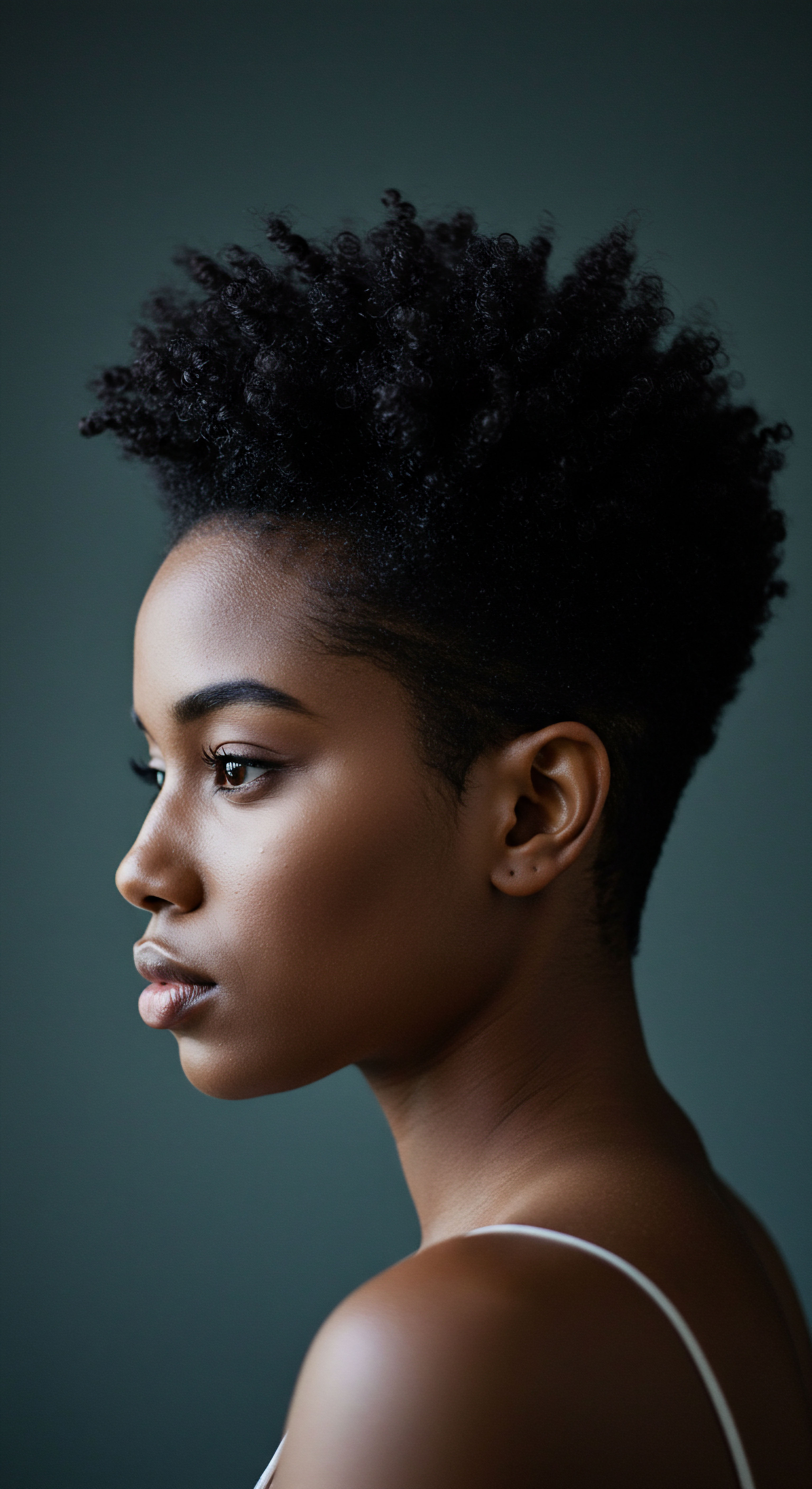
References
- White-Jolivette, Tammy. “African American Women’s Experience of Wearing Natural Textured Hair.” Walden Dissertations and Doctoral Studies, 2025.
- The Economics of the Natural Hair Movement ❉ The Rise of Loc/Dreadlocks Entrepreneur. MFL Team, 2023.
- The Official CROWN Act. CROWN Coalition, 2023 Workplace Research Study.
- “Hair Has Nothing to Do with Competency.” University of New Haven, 2021.
- The CROWN Act ❉ A Jewel for Combating Racial Discrimination in the Workplace and Classroom. Economic Policy Institute, 2023.
- Hair Discrimination Rampant for Black Women ❉ Survey. Canadian HR Reporter, 2023.
- Top Afromod Trends ❉ Suppliers, Cultural Shifts & E-commerce Growth. Accio.com, 2023.
- Addressing Hair Discrimination and Cultural Bias in Education. Education International, 2024.
- “Don’t Get It Twisted ❉ Untangling the Psychology of Hair Discrimination Within Black Communities.” Mbilishaka, Afiya M. American Journal of Orthopsychiatry, 2024.
- Study Reveals the State of Hair Discrimination in the Workplace. NewBeauty, 2023.
- The Evolution of Natural Hair Products for Black Women. The Jembe, 2023.
- The Natural Hair Revolution ❉ A Market Trend Analysis. The Kurl Kitchen, 2025.
- Why Londoners Are Switching to Natural Hair Care ❉ A Local Trend Explained. The Afro Hair Guide, 2025.
- Hairdressing Through the Decades. Shape Hair & Beauty Salon, 2023.
- Hair Care. Smithsonian Institution.
- The Texture Gap ❉ Type 4 Consumers are Continually Left Behind. The British Beauty Council, 2023.
- Roots of Black Hair Care. Living on Earth, 2024.
- The Hair-Raising Research About Beauty Products Marketed to Black Women. Environmental Working Group, 2019.
- The Black Identity, Hair Product Use, and Breast Cancer Scale. ResearchGate, 2019.
- Hair Inequality. The Anti-racist Hot Dog, 2023.